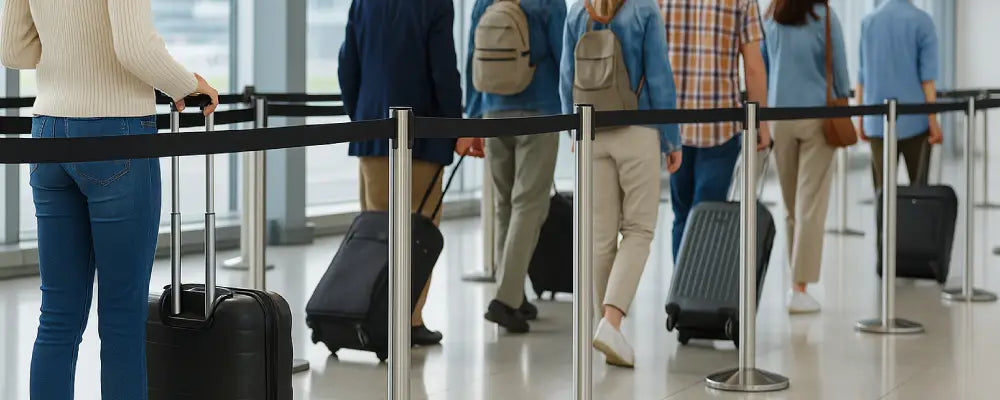What a Good Queue Should Do
A well-designed line protects people, prevents cutting-in, reduces wait-time anxiety, and keeps staff focused on service. Whether you manage a concert entry, an airport checkpoint, or a busy checkout bank, the right mix of posts, belts, and clear wayfinding will turn chaotic footfall into calm forward motion. The goal is predictable flow that’s safe, quick, and easy to reconfigure as demand shifts during the day with the queue barriers.
- Stabilize pedestrian speeds and eliminate cross-traffic.
- Keep aisles and fire egress unobstructed at all times.
- Create clear “next step” cues: where to join, wait, and exit.
Map the Layout & Capacity
Start with data: Hourly footfall, peak dwell time, and service positions staffed per interval. Sketch serpentine lanes for long waits and straight approaches for ID checks or payment terminals. Leave at least 1.2–1.5 m aisle width where trolleys, luggage, wheelchairs, or strollers are common. Add bypass lanes for VIPs, families, or assistance needs, and plan overflow spurs you can open in seconds.
- Use sightlines to avoid sharp turns at decision points.
- Place wayfinding at eye level and at the queue entrance.
- Forecast surges (flight banks, show times, lunch rush).
Pick the Right Hardware Type
Queue barrier solutions excel in everyday retail and venue entrances where modularity matters. A queue barrier with weighted bases, replaceable belts, and clip-on sign frames allows fast layout changes for promotions or staffing changes without tools.
A retractable barrier shines when you need quick setup and teardown for pop-ups, temporary closures, or lane redirection. Choose a retractable barrier with slow-retract safety braking, lockable belt ends, and fray-resistant webbing rated for high-traffic environments.
Choose a crowd control barrier for perimeter security, performer load-ins, or airside boundary lines where rigidity and height deter crossing. A crowd control barrier (steel or heavy-duty polymer) offers visible separation and impact resistance during peak surges.
Use a safety queue barrier in areas with elevated risk—sharp corners, equipment rooms, or construction-adjacent corridors. A safety queue barrier with high-visibility finishes and reflective end caps elevates conspicuity under mixed lighting.
Build in Safety & Accessibility
Stability, visibility, and access are non-negotiable. Weighted bases prevent tip-overs, anti-trip belt heights protect children, and contrasting colors or reflective accents improve recognition. Keep lanes wide enough for mobility devices and avoid tight S-curves. Ensure signs are readable from the approach distance at normal walking speeds and that emergency egress paths are never blocked.
- Minimum recommended belt height: ~100–110 cm for consistency.
- Use tactile floor cues near changes in direction or gates.
- Add swing gates for staff access and wheelchair pass-throughs.
Rollout and Optimize in Airports
In airports, queue barriers must handle constant passenger movement and sudden surges. Mark anchor points on the floor to ensure consistent deployment, and design layouts that can expand or contract depending on the time of day. During boarding, security checks, or immigration, flexible barrier setups prevent overcrowding and keep passengers moving efficiently.
- Boarding efficiency: Serpentine lanes keep large passenger groups organized.
- Security flow: Lanes must allow luggage, strollers, and wheelchairs without blocking emergency exits.
- Real-time adjustments: Barriers can be shifted quickly to manage delays or unexpected passenger surges.
FAQs
1) How do I size lanes for luggage or carts?
Target 1.5 m clear width where large items are common, with 90° turns avoided near checkpoints to prevent jams.
2) Belts or rigid panels—what’s better?
Belts are faster to reconfigure and store; rigid panels offer superior visual separation and brand space for messaging.
3) How often should I inspect the hardware?
Do quick daily checks for stability and weekly checks for wear, fasteners, and belt retractors; replace components proactively.





